Interprofessional case study activity encourages Waldron College students to collaborate
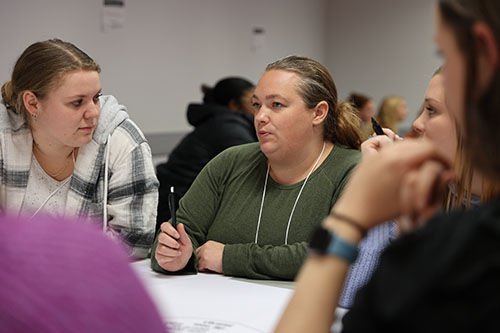
On a chilly fall morning, groups of six to eight students from several different programs within Radford University’s Waldron College of Health and Human Services huddled around tables in four conference rooms on the lower level of Heth Hall.
The groups — composed of approximately 150 students from the nursing, occupational therapy, social work and communication sciences and disorders programs — discussed Rosa Garcia, a sixth-grader at Christiansburg Middle School who moved to the area four years ago with her mother, father, two sisters and grandfather. The family lived in a 70-year-old rental house with heating problems and cockroaches, but they were afraid to complain to the landlord. Eight weeks ago, a fire tore through the home due to a faulty furnace. Rosa’s parents escaped unharmed with her sisters, but Rosa was trapped under a bookcase. As her grandfather tried to help her, he suffered smoke inhalation and had to be hospitalized.
By the time the firefighters rescued Rosa, she had smoke inhalation burns, her right foot had second- and third-degree burns, her right leg was broken, and her right hand was crushed by the bookcase. Due to a lack of oxygen during the fire, Rosa also suffered anoxia, which has resulted in aphasia and cognitive changes. Since the fire, Rosa has had surgeries to put pins in her ankle and several skin grafts on her foot. One became infected, so she still has daily dressing changes to this wound on her foot. She and her family don’t have much money, are now homeless and have lost everything they owned. Despite support from their church and agencies in the community, they are in a difficult situation.
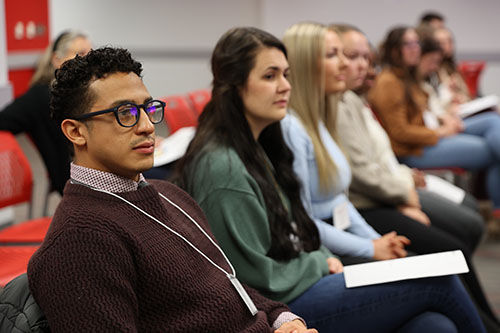
The incident and the Garcia family are entirely fictional — a scenario developed as part of the 13th annual fall 2023 Waldron College lnterprofessional (IPE) Case Study Activity, held on Nov. 3. Yet, it is a sequence of events that could happen in reality to many families across our region.
“We’ve always had a goal of making sure our students were communicating well with each other,” said Kerry Vandergrift, Ph.D., an associate professor in the school of social work, interim associate dean of interprofessional education and practice and diversity, equity and inclusion at Waldron College, and main organizer of the event. “This year, though, we adopted new interprofessional education collaborative competencies, including values, roles and responsibilities and communication. We designed the case study and the kinds of interactions the students were going to have to ensure the students meet these competencies.”
Vandergrift said that the first step in the activity was for the students to explore their own identities, cultures and experiences. Then, participants spoke about professional roles and responsibilities of the different team members. Finally, the groups’ moderators, composed of faculty from the various departments involved, stepped away to encourage the participants to more fully engage with each other.
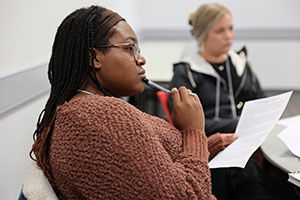
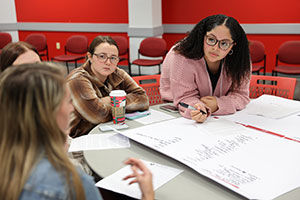
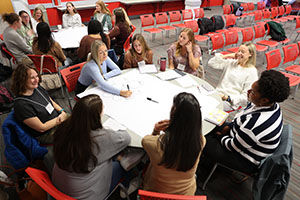
“We approached it that way for a couple of reasons,” Vandergrift said. “Exploring the communication aspect and the roles and responsibilities has always been a big part of this activity, but this approach ensures that the values competency is in the forefront of their minds as well. They are considering what their own identities are and how may they be different not only from the person they are caring for, but also from their fellow team members.”
Vandergrift said while it can be difficult to teach students how to be empathetic, these kinds of activities help to bring out that quality by personalizing the care they provide and increasing the bonds between team members.
“Thinking about how we connect to others promotes empathy,” Vandergrift said. “Differences don’t have to be weaknesses. We’re hoping the students consider how their differences are actually a strength because someone may bring something to the table that you don’t have. For example, a team member may be from another country similar to the person you are caring for. Their understanding of that culture can be a quality you don’t possess but can be a profoundly powerful tool to the healthcare team.”
Vandergrift says team member differences in age, national or cultural origins, religion, family structures and more can help inform the work a team does together and how they can relate to clients.
This personalized approach to IPE struck a chord with the students participating in the activity.
“I think knowing other people’s areas of expertise and understanding helps to deepen my understanding of how we can help the people we are working with,” said Melissa Kedrowitsch, a first-year Master of Social Work student and graduate teaching assistant in the social work department. “Everyone’s life experiences, both professionally and personally, can be very different, but when we come together, each one of us can be part of a complex machine that works together to accomplish a goal. I have a new respect for the other disciplines I’ve worked with today because I didn’t fully understand what they did before.”
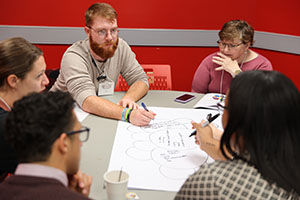
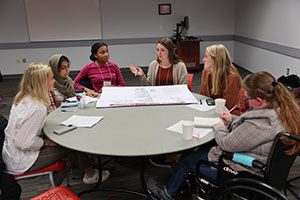
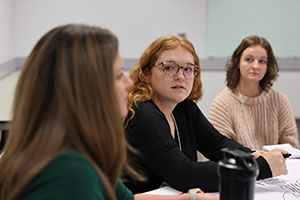
That kind of appreciation for other professionals’ skills and contributions through IPE activities has become an increasingly important part of the curriculum at Radford University and other institutions across the country that educate students in health and human services professions.
According to the World Health Organization, “Interprofessional education occurs when students from two or more professions learn about, from and with each other to enable effective collaboration and improve health outcomes. Once students understand how to work interprofessionally, they are ready to enter the workplace as a member of the collaborative practice team. This is a key step in moving health systems from fragmentation to a position of strength.”
Ruben Carlo, a senior in the Bachelor of Science in Nursing program, said he believes these kinds of activities are invaluable, and he would like to experience them more often.
“This activity helped me to broaden my understanding of the resources I have at hand with my team members — the tools I already have under my belt that I didn’t know were there,” Carlo said. “The way we did this activity helped me understand that I can rely on my interdisciplinary team to help me be the best professional I can be. If someone on my team is from rural Appalachia, for example, you can work through that colleague to communicate more effectively with someone who may not understand why they have to follow our guidance to get better. The power of persuasion can be powerful when you feel a connection to someone.”